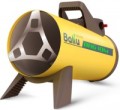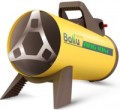Max. thermal output
The highest heating power produced by an industrial heater.
The maximum area that the unit can effectively heat directly depends on this parameter (see below). Even if it is not indicated in the specs, it can be approximately determined from the calculation that for heating 1 m² of a room with a standard ceiling height of 2.5 m and good thermal insulation will require 100 W of thermal power. If the ceiling height is significantly different, then the power required for heating can already be withdrawn from the volume of the room — every 2.5 cubic metres of volume will require the same 100 W (and the volume is found by multiplying the area by the height of the ceiling). There are also more complex formulas for the most accurate calculation, taking into account the degree of thermal insulation, the temperature difference between inside and outside the room, etc.; they can be found in special sources.
Note that in electric models (see "Power supply"), the maximum thermal power, in addition to all of the above, also determines the total power consumption of the unit: the power consumption (see below) cannot be less than the thermal output (usually, it is somewhat higher due to for the removal of part of the energy for the operation of the fan). In devices with a water circuit, the actual thermal output depends on the temperature of the coolant at the inlet and outlet. Therefore, in the characteristics, a certain standard value is usually indicated, and in t...he notes, it is specified for which temperatures it is relevant (for example, 90 ° / 70 °).
Max. heating area
A very conditional parameter that slightly characterizes the purpose by the size of the room. And depending on the height of the ceilings, the layout of the room and the equipment, the actual values may differ significantly. Nevertheless, this item represents the maximum recommended area that the heat gun can effectively heat.
When determining the maximum area, usually, a universal formula is used that is valid for all heaters: 1 m² of floor space in a room with a standard ceiling height of 2.5 m requires 100 W of thermal power. Therefore, if the ceiling height differs markedly from this value, the actual heating area should be recalculated; for more details on scaling, see “Maximum thermal output".
Rated current
The current consumed by the heat gun during normal operation. This parameter is useful primarily for assessing the load on the mains that occurs during the operation of the unit and organizing the appropriate connection. In particular, the rated current of the fuse installed in the connection circuit cannot be lower than the total rated current of the connected load — otherwise, the power will be turned off. Heat guns (primarily electric, see "Power supply") are quite high consumption consumers in terms of current.
Power consumption
The power consumed by the electrical components of the industrial heater during operation.
This parameter allows, first of all, to assess the load on the power grid and the suitability of the available power for the normal operation of the unit. It is relevant for all types of modern industrial heaters (see "Power supply"). However, it is worth noting that in some electric models, the power consumption is indicated for the ventilation mode. In this mode, the heating element is not activated, and the power consumption is extremely low — a few tens of watts. In such cases, the total power can be estimated from the maximum thermal output (see above) — in electrical models, these parameters practically do not differ from each other.
Airflow
The maximum amount of air that an industrial heater can pass through itself in a certain time.
This parameter is associated with an increase in air temperature (see above): at constant power, higher performance usually corresponds to a smaller temperature difference. Accordingly, a more efficient industrial heater will heat the entire volume of the room faster, but the heating temperature will be lower. So, it is worth choosing according to this parameter, taking into account what is more important for you — a large temperature difference or a high heating rate.
Max. fuel consumption
Fuel consumption during operation of a gas or diesel (see "Power source") industrial heater at maximum power.
This parameter determines the efficiency of the unit; on the other hand, high power is inevitably associated with high consumption, therefore, only models with the same power source that do not have significant differences in power can be compared with each other in terms of high consumption. In addition, knowing the volume of the fuel tank (see above) or gas cylinder, this parameter can be used to calculate the time during which the heat gun can continuously work regardless of the selected power (for more details, see "Maximum operating time"). Note that this time is usually less than the maximum.

